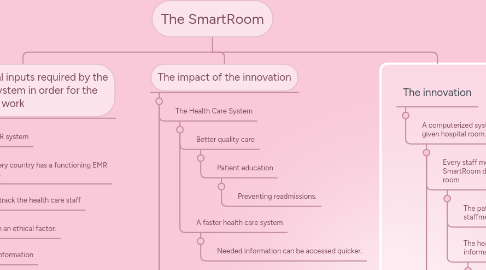
1. The additional inputs required by the health care system in order for the innovation to work
1.1. A working EMR system
1.1.1. Not every country has a functioning EMR system.
1.2. Allowence to track the health care staff
1.2.1. Contain an ethical factor.
1.3. The relevant information
1.3.1. A clear description in tasks for each health care professional
1.3.1.1. It is important that the task are clear, so the relevant information each health care profession is offered when entering the room is correct.
2. The impact of the innovation
2.1. The Health Care System
2.1.1. Better quality care
2.1.1.1. Patient education
2.1.1.1.1. Preventing readmissions.
2.1.2. A faster health care system
2.1.2.1. Needed information can be accessed quicker.
2.2. Health Care Practitioner
2.2.1. Better quality care
2.2.1.1. Easy access to needed information
2.2.1.2. Better tools to educate the patient
2.2.1.3. Easier to prioritize the tasks and communicate.
2.3. Health Care Client
2.3.1. Patient Empowerment
2.3.1.1. More education available
2.3.1.2. More transparency in the patient trajectory
3. The innovation
3.1. A computerized system that detects who is in a given hospital room.
3.1.1. Every staff member wears a tag, which the SmartRoom detects when someone enters the room
3.1.1.1. The patients relevant information for the given staffmember shows up on screen.
3.1.1.2. The health care workers can access clinical information retrieved from the EMR
3.1.1.2.1. Medications, Laboratory Results, Vital Signs.
3.1.1.2.2. They can also send information back to the EMR system
3.1.2. The staff can use the computerized system to educate the patients and the family on the patient's condition
3.1.3. The patient and family can use the SmartRoom on the in-room television
3.1.3.1. Patient can view entertainment functions, education materials, see what tests are being done that day, see when pain medication is due, access emails, play games, and request non-urgent items.
3.1.4. An overview for the staff.
3.1.4.1. Can see the different tasks, that needs to be done.
3.1.4.2. They can see which patient is being treated by which nurse or physician.
3.1.4.3. They can easily message each other
